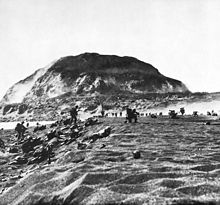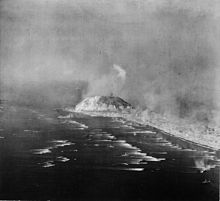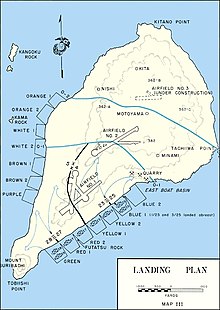Battle of Iwo Jima
24.7833141.316667Coordinates: 24° 47′ 0″ N, 141° 19′ 0″ E
Battle of Iwojima
Part of: World War II, Pacific War
.jpg)
The second flag on the volcano Suribachi
Overview - Pacific War
The Battle of Iwojima refers to the battle for the island of Iwojima, barely 24 square kilometres in size, fought towards the end of the Second World War between the armed forces of Japan and the USA as part of the Pacific War. This extremely bloody and costly battle lasted from February 19 to March 26, 1945, and is now considered a prime example of a classic amphibious landing operation.
Especially in the US, it is considered one of the most famous battles of World War II, as the fighting caused the highest casualty rate in the history of the USMarine Corps. The picture Raising the Flag on Iwo Jima, taken there, became one of the most famous war photographs ever.
It was the only battle of the Pacific War in which the total losses (killed and wounded) of the Allies were higher than those of the Japanese.

105-mm gun in the black sands of Iwojima

Destroyed American Amtracs

Marines of the 5th Division in the LZ, Suribachi in the background.

Part of the invasion fleet off the island

The tunnel system built by Japanese soldiers on Iwojima (drawing by a US soldier)

Operation Detachment US map
Objectives of the battle
The importance of the island of Iwojima (today: Iōtō), which belonged to the Ogasawara Islands (Bonin Islands), as a starting point for both tactical and strategic air operations had already been recognized in the course of the bombing raids planned from the Marianas. In October 1944, the United States Joint Chiefs of Staff gave their approval for the capture of the island, barely 24 km² in size, in order to be able to station P-51 Mustang escort fighters for the B-29 Superfortress bombers flying to Japan; it was also to serve as an emergency landing site for bombers that had been hit or damaged. The location of the island, about 1000 km south of Tokyo, was ideal for these purposes, and the airfields there had three runways (one of which was under construction) from which Japanese air forces had so far flown their attacks against the US bombers. In addition, from here the mother country was warned by radio of incoming air attacks, so that Japan could prepare its fighters and flak. In addition, Boeing B-29 bombers flying over Iwojima without escort fighters were attacked by Japanese fighters stationed there, such as the J2M Raiden.
The Japanese forces had realized that the superior attackers would have been unstoppable in an open battle on the island's shores. Instead, they entrenched themselves in an extensive system of trenches and tunnels, primarily in the hills, to wage a hidden defensive struggle against the U.S. forces and make conquest of the island impossible. The aim was to delay the invasion of the Japanese mainland and to deter and weaken the attackers by relentless resistance.
The battle
The battle began on 15 February 1945 with a three-day bombardment by the naval artillery of Task Force 58 and bombardment by USAAF units from the Marianas, but this caused little damage to the well-fortified Japanese positions because of the hard rock of the island. At 8:30 a.m. on 19 February 1945, Operation Detachment began, the landing of 30,000 Marines from the 4th and 5th Marine Infantry Divisions of the V. Amphibious U.S. Corps at the Green I, Red I, II, Yellow I, II, and Blue I, II landing sections. Heavy fighting ensued, resulting in approximately 2,400 soldiers killed on the first day.
The U.S. initially had great difficulty with the loose, warmed ground, which hampered all activities, from unloading equipment to infantrymen crawling. The 3rd U.S. Marine Division, which had arrived for reinforcements, increased the crowding on the amphibious beach landing zones, causing additional casualties.
The fierce resistance of the Japanese forces, consisting of 14,000 men of the 109th Army Division and 7,000 soldiers of the ground forces of the Imperial Japanese Navy under the supreme command of Lieutenant General Tadamichi Kuribayashi, led US generals to even consider the use of chemical weapons, which, however, was categorically rejected by President Franklin D. Roosevelt categorically rejected.
One of the most hotly contested areas was the extinct Suribachi volcano, which jutted out over the landing sections. Neither grenades nor bombs helped against the strong Japanese pillboxes, which were secured by over 200 gun emplacements, so that the emplacements had to be conquered one by one in close combat with hand grenades and flamethrowers.
The Japanese defense was well organized, as natural caves had been developed and connected to observation posts and battle positions by tunnels. Nevertheless, the Marines were able to cross the center of the island on the first day. The Japanese positions on Mount Suribachi were cut off by destruction of underground communications over the following days. The soldiers of the 28th U.S. Marine Regiment climbed the volcano's ravine-strewn slopes fighting, killing most of the enemy remaining in the caves with flamethrowers.
On February 23, 40 soldiers, led by Lieutenant Harold G. Schrier, reached the summit and raised a U.S. flag. This flag was replaced a few hours later by a larger one, and a photograph taken by Joe Rosenthal - for which he later won the Pulitzer Prize - shortly afterwards became famous under the title Raising the Flag on Iwo Jima and probably the most reproduced image of all time.
After the loss of the positions on Mount Suribachi, the Japanese commander Kuribayashi massed his main force on the hills to the north, from where the fighting was carried on with doggedness. Not a single Japanese loophole was taken until the defenders were dead. Positions such as "Height 362," which consisted of a huge tunnel structure, were sealed by bricking up the entrances, trapping the remaining Japanese soldiers.
By the second week of March, the surviving Japanese were huddled on the Kitano headland. The U.S. soldiers fought their way to No. 2 Airfield west of Elevation 382 and were reinforced by three divisions. On March 16, 1945, they broke through the Japanese defensive line. Against a final group of about 500 Japanese soldiers, U.S. sappers used mines, the explosions of which shook the entire island. The island was declared safe on March 26, 1945, but skirmishes with Japanese soldiers in hiding continued thereafter. By June 1945, another 2,409 Japanese had been killed or captured.
The US deployed an unknown number of aircraft and about 900 ships for the capture of Iwojima. They deployed about 110,000 troops, of whom 6,821 were killed and 19,217 wounded. On the side of the Japanese defenders, between 19,845 and 20,375 soldiers died. At least 1,083 Japanese surrendered and became prisoners of war, but only 219 of these during the actual fighting. The end of the commander of the Japanese troops, Tadamichi Kuribayashi, was never clarified.
A Superfortress bomber was able to land on the island for the first time on March 4, and fighter planes were stationed at No. 1 Airfield from March 11. By the end of the war on August 15, 2,251 Superfortress bombers had landed on Iwojima. However, the island never attained the expected strategic importance that was used to justify, among other things, the high casualties of U.S. soldiers.
The few square miles of Iwojima caused as many casualties as the Luzon landings - an argument used in the U.S. by the opposition Hearst press to demand that General Douglas MacArthur be given command of the entire Pacific "because he was (at least) saving the lives of his own people." Of the more than 6,800 dead on the American side, 5,931 were Marines, which was nearly one-third of all Marines killed in all of World War II and represented the highest casualty figures of any battle in the history of the U.S. Marine Corps.
Search within the encyclopedia